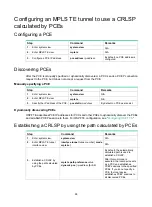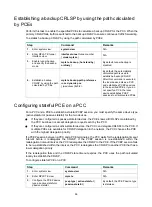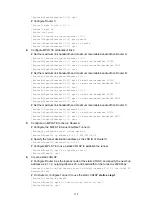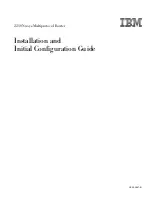
103
Bandwidt
h required
by
primary
CRLSP
Primary
CRLSP
requires
bandwidth
protection or
not
Bypass tunnel providing
bandwidth protection
Bypass tunnel providing no
bandwidth protection
None-zero Yes
The primary CRLSP can be
bound to the bypass tunnel when
all the following conditions are
met:
•
The bandwidth that the
bypass tunnel can protect is
no less than the bandwidth
required by the primary
CRLSP.
•
There is not a CT specified
for the bypass tunnel, or the
specified CT is the same as
that specified for the primary
CRLSP.
After binding, the RRO message
carries the bandwidth protection
flag, and the bypass tunnel
provides bandwidth protection for
the primary CRLSP.
The primary CRLSP prefers
bypass tunnels that provide
bandwidth protection over those
providing no bandwidth
protection.
The primary CRLSP can be bound
to the bypass tunnel when one of
the following conditions is met:
•
No CT is specified for the
bypass tunnel.
•
The specified CT is the same
as that specified for the
primary CRLSP.
After binding, the RRO message
does not carry the bandwidth
protection flag.
This bypass tunnel is selected only
when no bypass tunnel that
provides bandwidth protection can
be bound to the primary CRLSP.
Non-zero No
The primary CRLSP can be
bound to the bypass tunnel when
all the following conditions are
met:
•
The bandwidth that the
bypass tunnel can protect is
no less than the bandwidth
required by the primary
CRLSP.
•
No CT that the bypass
tunnel can protect is
specified, or the specified
CT is the same as that of the
traffic on the primary
CRLSP.
After binding, the RRO message
carries the bandwidth protection
flag.
This bypass tunnel is selected
only when no bypass tunnel that
does not provide bandwidth
protection can be bound to the
primary CRLSP.
The primary CRLSP can be bound
to the bypass tunnel when one of
the following conditions is met:
•
No CT is specified for the
bypass tunnel.
•
The specified CT is the same
as that of the traffic on the
primary CRLSP.
After binding, the RRO message
does not carry the bandwidth
protection flag.
The primary CRLSP prefers
bypass tunnels that does not
provide bandwidth protection over
those providing bandwidth
protection.
Configuration restrictions and guidelines
When you configure a bypass tunnel on the PLR, follow these restrictions and guidelines:
•
Use bypass tunnels to protect only critical interfaces or links when bandwidth is insufficient.
Bypass tunnels are pre-established and require extra bandwidth.
















































